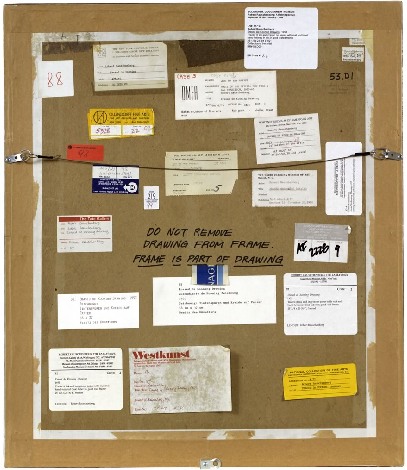So ultimately, Norman Mailer's off the hook. We know that when he wrote about Erased de Kooning Drawing in the 1970s, 1980s, Mailer fragged Rauschenberg for selling it--which he hadn't--as much as making it. And he got the title wrong: "A drawing from Willem de Kooning erased by Robert Rauschenberg". Which might mean he never went to see it anywhere it was showing over the years, but it also means he probably felt he got the work, didn't need to see it. And that he was reading art historian Leo Steinberg's indispensable 1975 collection of writings, Other Criteria.
That particular wrong version of the inscription on EdKD comes from Steinberg's title essay, which was first published in Artforum in 1972 as "Reflections on the State of Criticism." Steinberg originally presented a version of "Reflections" as a lecture at the Museum of Modern Art in March 1968. It was one of a 10-part series of Wednesday night lectures by leading critics and historians [which happens to have been organized by the Modern's Junior Council then chaired by Barbara Jakobson, which is the predecessor group to the group I chaired for a while, the Junior Associates. Needless to say, I have never felt like a bigger slacker than when I look back at all the stuff the Junior Council did in the 60s. Recordings of the series were restored in 2008, but the Steinberg lecture is not listed among them. I'll look into that.]
Anyway, Steinberg's piece is an epic refutation of Greenbergian modernism's view of both Renaissance and contemporary art. For its compelling critical framework, its defense of content and for identifying what Steinberg called the "flatbed picture plane," Branden Joseph dubbed "'Other Criteria' the single most important article on Rauschenberg's production."
Steinberg discussed EdKD along with a 1952 grass painting hung on the wall as an example of Rauschenberg's early challenges to conventional expectations of orientation:
In retrospect, the most clownish of Rauschenberg's youthful pranks take on a kind of stylistic consistency...When he erased a de Kooning drawing, exhibiting it as "Drawing by Willem de Kooning erased by Robert Rauschenberg," he was making more than a multifaceted psychological gesture; he was changing--for the viewer no less than for himself--the angle of imaginative confrontation; tilting de Kooning's evocation of a worldspace into a thing produced by pressing down on a desk.Which is interesting, but maybe not quite as interesting as the fact that, as late as 1972 or even 1975, one of Rauschenberg's greatest critical champions seems not to have noticed that his version of the inscription is actually incorrect. Or that the earliest exhibition date listed on the back of EdKD itself is actually 1973, in a show by an even closer Rauschenberg ally, Susan Ginsburg.

[Interesting sidebar: after posting SFMOMA's photo of the back of EdKD, a regular greg.org reader told me s/he had seen EdKD getting reframed or rematted "in the late nineties" at Minagawa, and watched as they carefully reattached the archival materials on the back. Maybe Bob was sprucing it up before selling it.]
So anyway, as of the publication of Other Criteria, then, Steinberg considered Erased de Kooning Drawing as a "youthful prank" that was "clownish," yet prescient. But it's not clear that the great advocate of close looking had actually seen the work.
Part 1: 'FRAME IS PART OF DRAWING'
Part 2: Erasers Erasing in Painters Painting
Part 3: Norman Mailer on Erased de Kooning and other 'hopeless' and 'diminished' art












